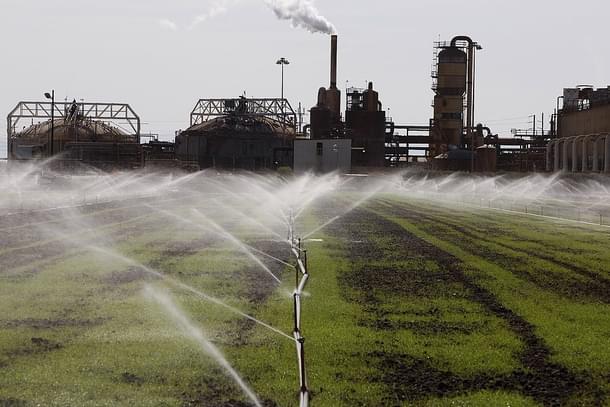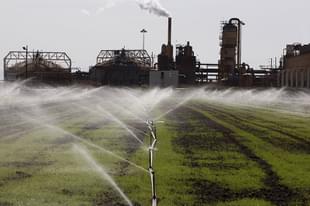Ideas
‘Smart Farming’ Is What Rajasthan Thinks Is The Way Forward For The State
Swarajya Staff
Nov 11, 2016, 12:02 PM | Updated 12:01 PM IST
Save & read from anywhere!
Bookmark stories for easy access on any device or the Swarajya app.


While the neighbouring Madhya Pradesh and Gujarat have scripted remarkable success stories in transforming the agriculture, Rajasthan has till now made only a steady progress. Despite a few breakthroughs in transitioning to new cropping patterns (olives and dates), a quick glance at the agriculture economy numbers of Rajasthan suggests that it has considerable distance to go, before it gathers the momentum to be an ‘breakout state’ in agriculture. Nearly 70 per cent of the population still dependent on farming though the contribution of agriculture and allied activities (gross state domestic product) is just around 25 per cent. The state continues to depend on rain-fed irrigation except in few pockets. The semi-arid and arid conditions add to the complexity of transforming the state’s agriculture.
Despite its staggering structural challenges, Rajasthan now is making a daring attempt to make sweeping productivity gains and leapfrog into an agricultural powerhouse by leveraging evolved and emergent technologies in agriculture. Rajasthan is clearly betting on adopting and scaling up ‘Smart Farming’ to achieve this.
In the context of agriculture, ‘Smart Farming’ is not merely a hyperbole used to describe the state of futuristic technologies. Mature technologies are already available in vogue across the world. For instance, a group of commercial farmers in the US are growing pesticide-free produce inside industrial warehouses with the help of LED-based artificial lighting. This effectively nullifies the role of weather as a variable in the farming equation. As The Economist, writing on the future of farming, observed: “Farms are becoming more like factories: tightly controlled operations for turning out reliable products, immune as far as possible from the vagaries of nature".
'Smart Farming’ techniques combined with other emerging ones, including Genome editing, Internet of Things-enabled intelligent farm equipments, use of drone, vertical farming robotics are clearly set to revolutionise agriculture.
GRAM Initiative To Kickstart ‘Smart Farming’
Global Rajasthan Agritech Meet (GRAM 2016) that concludes in Jaipur today was a novel initiative by the Rajasthan Government to showcase the best global practices and technologies in ‘Smart Farming’, suitable to its farmers. Held at the sprawling Jaipur Exhibition & Convention Center (JECC), the event witnessed the convergence of farmers, investors, manufacturers, agri entrepreneurs, agriculture scientists, academicians and researchers.
“Per Drop More Drop” resonated throughout the proceeding of the event as manufacturers and technologists presented many intelligent farming techniques, from affordable drip watering to advanced hydroponics, to more than 50,000 farmers, who were mobilised for participation in the event.
When we talk about per drop more crop, we need to understand the significance of judicious use of water. More than 80 per cent of water in India is used in agriculture, rest is used for domestic and industrial purposes. So, if we can lower our use of water in agriculture or start using the available water more efficiently, this would go a long way.
What we can do? Well, for starters, we can make micro-irrigation mandatory at least for the water guzzling crops like rice and sugarcane. A total of 69 million hectares can be brought under micro-irrigation, but in the last 10 years we have only brought about 7 million hectares. The pace is too slow and will take us a century at this rate. The target should be set at 10 years. To achieve this, we need to have a stable and long-term policy environment in place. As explained in yesterday’s piece on GRAM 2016, precision farming – by using automation we can do wonders in saving not just water but help put fertilisers and soil to better use, in addition to reducing labour costs.
How automation can help? Well, currently without it, we over-irrigate as we cannot be sure how much exactly the soil needs. This leads to poor quality of produce and in turn lower returns. With automation, the fields will be irrigated exactly the way they should be: with optimum use of water and fertilisers. Automation can also make night irrigation feasible which means less use of water, thus less pumping hours, hence less electricity, which in turn means lower cultivation costs.
In pulses, automation can reduce seepage losses and run off which will translate into better use of water. Farmers will save a lot of money since labour costs will come down, given the fact that irrigation and fertigation can now be done by installed system, automatically anticipating the needs of the soil and crop. Use of sensors can help farmers avoid excess irrigation in the event of rainfall. The possibilities are endless.
What Rajasthan Can Do In The Short Term...
So, what can Rajasthan do in the short term? There are many challenges before the state, if it wants to go for ‘Smart Farming’. Three are prominent among these: providing cost-effective farm equipments, setting up costs and dissemination of information and training to the farmers.
Currently, the costs are out of reach for at least the small and marginal farmers. They simply cannot afford the equipments. Here, scientific community will have to rise to the occasion and come up with low-cost farming equipment. For this, the government should start pumping in more money in research and development in this sector. Meanwhile, subsidies can be provided to farmers. The government can also encourage industry to give more funds for this purpose under its corporate social responsibility programme. Initial demonstration of the system’s success to farmer is important. If he sees his incomes rise and input costs reduce, he wouldn’t hesitate to take risks.
Unlike in the west, our farmers aren’t very comfortable with technology. And automation involves complex programming. Here, industry and the government both can come to the rescue of illiterate farmers. They can hold special state-wide sessions, which involves training farmers in operating the complex set-up. It shouldn’t be hard. Our farmers may not be comfortable with technology right now but they are eager to adopt new ways.
Dissemination of information and to remain updated continuously with latest information regarding the technology is a challenge, which can be overcome in the long run as Digital India initiative becomes a success, especially in the rural heartland.
Electricity is a major challenge in villages even now. When we talk about well-programmed irrigation system, it means it would require power at exactly the same time it is programmed to run. So, erratic power supply is a major challenge, which the government needs to focus on.





